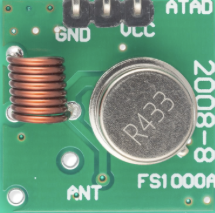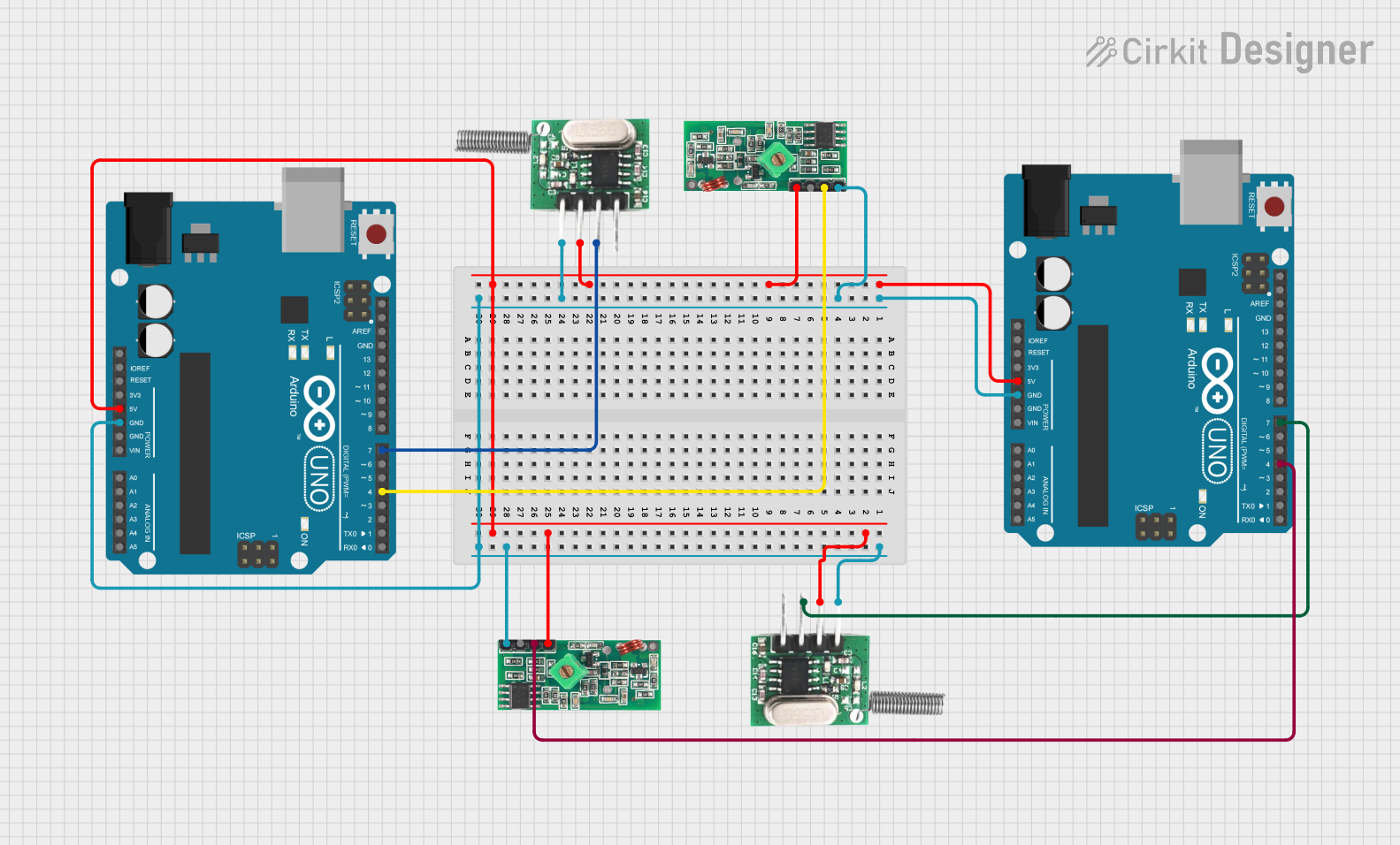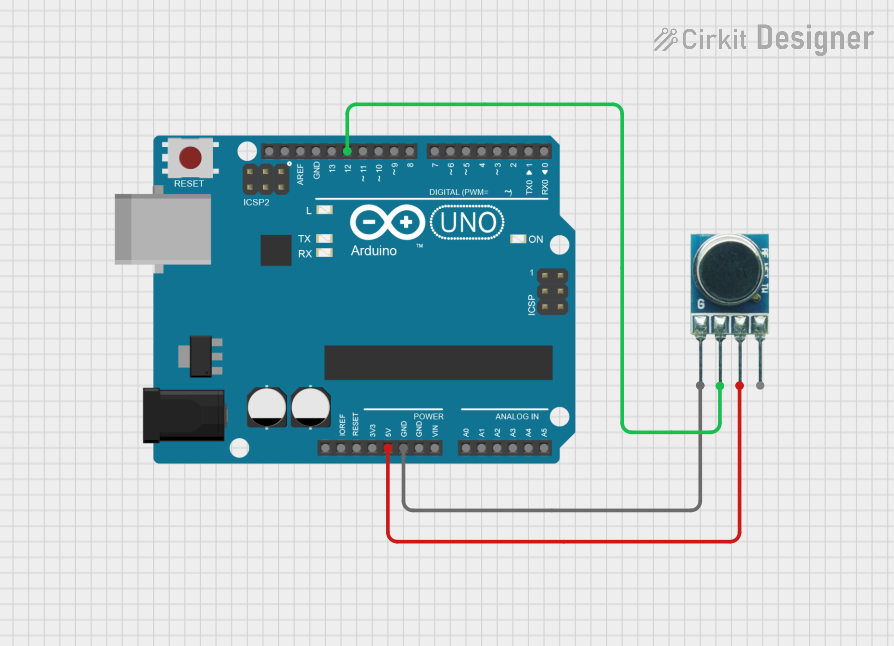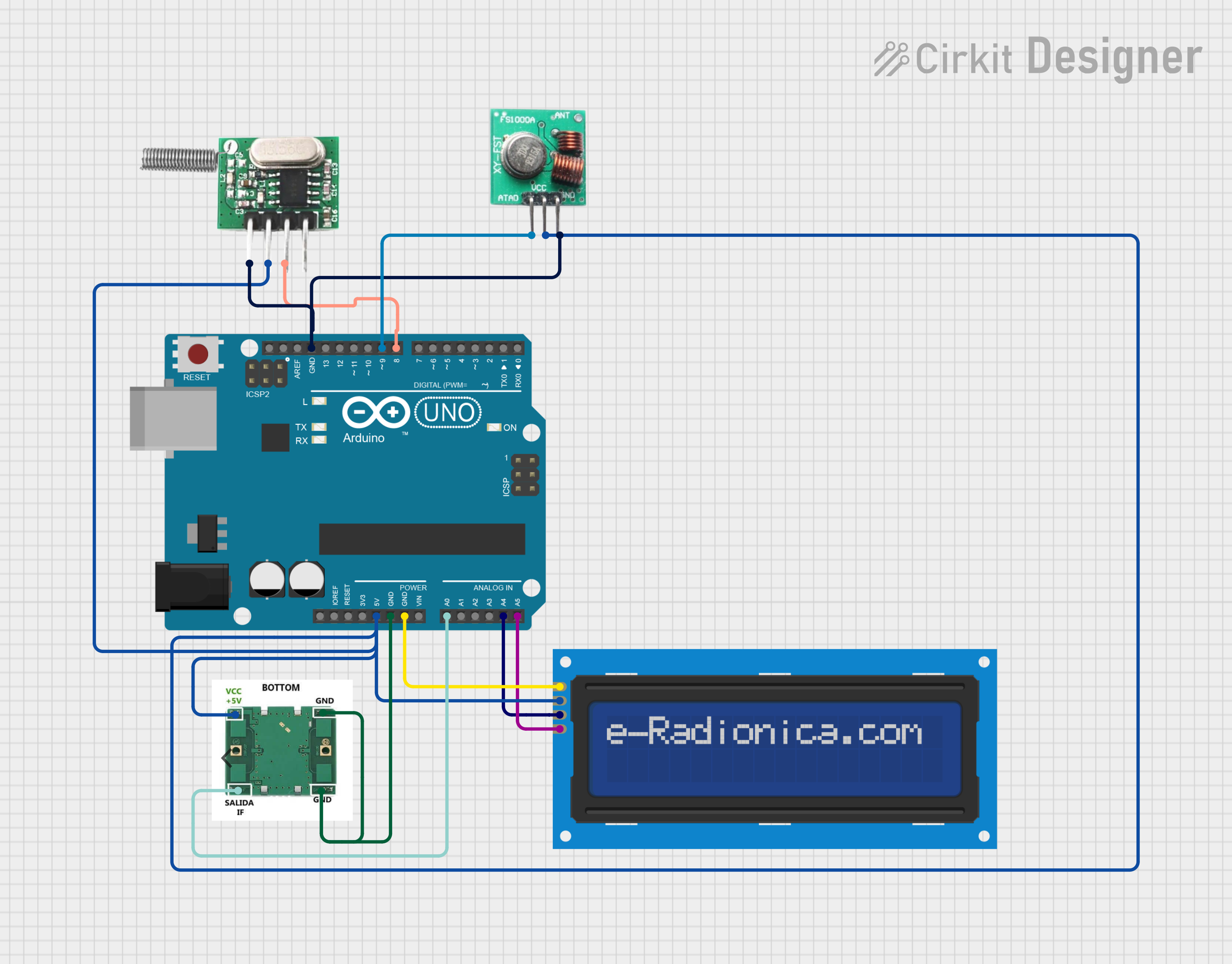
How to Use 433 MHz RF Transmittor: Examples, Pinouts, and Specs

 Design with 433 MHz RF Transmittor in Cirkit Designer
Design with 433 MHz RF Transmittor in Cirkit DesignerIntroduction
The 433 MHz RF Transmitter is a compact and cost-effective device designed to transmit radio frequency signals at 433 MHz. It is widely used in wireless communication systems, including remote controls, wireless sensor networks, home automation, and other short-range communication applications. This transmitter module is ideal for projects requiring low-power, reliable, and efficient wireless data transmission.
Explore Projects Built with 433 MHz RF Transmittor

 Open Project in Cirkit Designer
Open Project in Cirkit Designer
 Open Project in Cirkit Designer
Open Project in Cirkit Designer
 Open Project in Cirkit Designer
Open Project in Cirkit Designer
 Open Project in Cirkit Designer
Open Project in Cirkit DesignerExplore Projects Built with 433 MHz RF Transmittor

 Open Project in Cirkit Designer
Open Project in Cirkit Designer
 Open Project in Cirkit Designer
Open Project in Cirkit Designer
 Open Project in Cirkit Designer
Open Project in Cirkit Designer
 Open Project in Cirkit Designer
Open Project in Cirkit DesignerTechnical Specifications
Below are the key technical details of the 433 MHz RF Transmitter:
| Parameter | Value |
|---|---|
| Operating Frequency | 433 MHz |
| Operating Voltage | 3.3V - 12V |
| Operating Current | 9 mA (typical at 5V) |
| Transmission Range | Up to 100 meters (line of sight) |
| Modulation Type | Amplitude Shift Keying (ASK) |
| Data Rate | Up to 10 kbps |
| Dimensions | ~19mm x 19mm x 7mm |
Pin Configuration and Descriptions
The 433 MHz RF Transmitter typically has 4 pins. Below is the pinout and description:
| Pin | Name | Description |
|---|---|---|
| 1 | VCC | Power supply pin. Connect to a voltage source between 3.3V and 12V. |
| 2 | DATA | Data input pin. Connect to the microcontroller or data source. |
| 3 | GND | Ground pin. Connect to the ground of the circuit. |
| 4 | ANT | Antenna pin. Connect to a wire or external antenna for better signal strength. |
Usage Instructions
How to Use the 433 MHz RF Transmitter in a Circuit
- Power Supply: Connect the VCC pin to a regulated power source (3.3V to 12V). Ensure the power supply is stable to avoid signal distortion.
- Data Input: Connect the DATA pin to the microcontroller's digital output pin or any other data source. This pin transmits the digital signal as RF.
- Ground Connection: Connect the GND pin to the ground of the circuit to complete the circuit.
- Antenna: Attach a wire (approximately 17 cm for 433 MHz) to the ANT pin to act as an antenna. This improves the transmission range and signal quality.
Important Considerations and Best Practices
- Antenna Design: Use a properly sized antenna (quarter-wavelength, ~17 cm) for optimal performance.
- Power Supply: Use a decoupling capacitor (e.g., 0.1 µF) near the VCC pin to filter noise from the power supply.
- Interference: Avoid placing the transmitter near metal objects or other RF devices to minimize interference.
- Data Encoding: Use a suitable encoding scheme (e.g., Manchester encoding) to ensure reliable data transmission.
Example: Connecting to an Arduino UNO
Below is an example of how to use the 433 MHz RF Transmitter with an Arduino UNO to send data:
Circuit Connections
- Connect the VCC pin of the transmitter to the 5V pin of the Arduino.
- Connect the GND pin of the transmitter to the GND pin of the Arduino.
- Connect the DATA pin of the transmitter to digital pin 12 of the Arduino.
- Attach a 17 cm wire to the ANT pin as an antenna.
Arduino Code Example
// Example code to send data using the 433 MHz RF Transmitter
// Ensure you have the "RadioHead" library installed for this example
#include <RH_ASK.h> // Include the RadioHead ASK library
#include <SPI.h> // SPI library is required by RadioHead (even if not used)
RH_ASK rf_driver; // Create an instance of the RF driver
void setup() {
rf_driver.init(); // Initialize the RF driver
}
void loop() {
const char *msg = "Hello, World!"; // Message to be transmitted
rf_driver.send((uint8_t *)msg, strlen(msg)); // Send the message
rf_driver.waitPacketSent(); // Wait until the message is sent
delay(1000); // Wait 1 second before sending the next message
}
Troubleshooting and FAQs
Common Issues and Solutions
No Signal or Poor Range:
- Ensure the antenna is properly connected and of the correct length (~17 cm for 433 MHz).
- Check the power supply voltage and ensure it is within the specified range (3.3V - 12V).
- Avoid obstructions or interference from other RF devices.
Data Transmission Errors:
- Use a reliable encoding scheme (e.g., Manchester encoding) to reduce errors.
- Verify that the transmitter and receiver are operating at the same frequency (433 MHz).
Interference with Other Devices:
- Use the transmitter in a less crowded RF environment.
- Add shielding or move the transmitter away from other electronic devices.
FAQs
Q1: Can I use the 433 MHz RF Transmitter without an antenna?
A1: While it is possible, the transmission range and signal quality will be significantly reduced. It is highly recommended to use a properly sized antenna.
Q2: What is the maximum range of the 433 MHz RF Transmitter?
A2: The maximum range is up to 100 meters in an open, line-of-sight environment. Obstacles and interference can reduce the range.
Q3: Can I use this module with a 3.3V microcontroller?
A3: Yes, the module can operate at 3.3V. However, ensure the microcontroller's output voltage is sufficient to drive the DATA pin.
Q4: Is this module compatible with the 433 MHz RF Receiver?
A4: Yes, the 433 MHz RF Transmitter is designed to work with a corresponding 433 MHz RF Receiver for wireless communication.
By following this documentation, you can effectively integrate the 433 MHz RF Transmitter into your projects for reliable wireless communication.